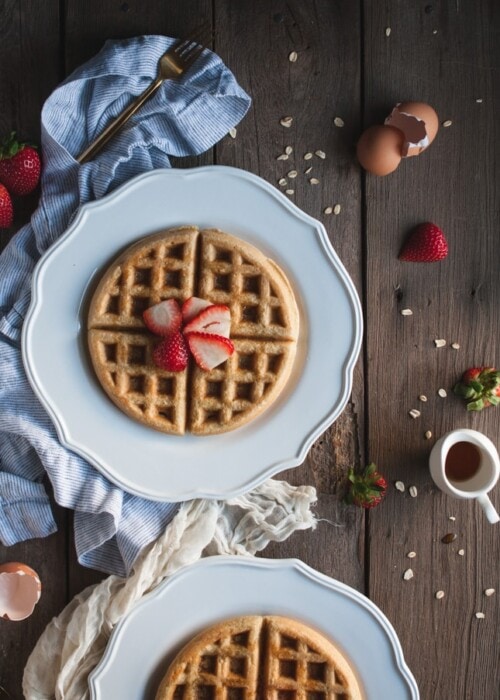Make oat flour pancakes using your blender to make your own oat flour that turn out as fluffy as traditional pancakes but healthier! With a nutty wholesome oatmeal-like flavor they’re delicious on their own or with chocolate chips, blueberries or whatever else you want to add in. They’re easy to make and reheat well for quick weekday breakfasts too!

Why You’ll Love this Recipe
These oat flour pancakes are a favorite in our house! They’re perfectly fluffy, easy to make, kid-friendly yet healthy, gluten-free, dairy-free and an overall great recipe for getting in your whole grains. Oat flour creates a slightly nutty flavor but grinding them up into oat flour mimics all purpose flour well enough that they still hit the spot.
Using oat flour in pancakes creates way more satiety than traditional pancakes making you feel full longer. While they don’t taste like oatmeal, they don’t call them oatmeal pancakes for nothing! Eating a stack of these really fills you up. They’re loaded with fiber and have more protein than standard all purpose flour or even whole wheat pancakes have. This means you’ll be less tempted to snack and eat unhealthy things later on.
Overall, these hearty oat flour pancakes are a delicious alternative and a healthier option with numerous benefits. We alternate from these, my almond flour pancake recipe and green pancakes (made with oat flour and spinach) pretty regularly.

Ingredients Needed
With just a few simple ingredients you can start your day off on healthier note, in the most delicious way possible.
- oat flour or raw oats – if needed, make sure to use oats or oat flour labeled gluten-free. If making your own oat flour, use rolled oats (aka old fashioned oats) for the best results.
- baking powder – absolutely necessary to get fluffy pancakes since they won’t rise as much without it.
- salt – I always use Himalayan pink salt but sea salt or your favorite every day salt works fine here.
- cinnamon – optional but recommended! It gives a subtle depth of flavor that complements the oat flour so well here.
- eggs – regular large eggs are what you’re looking for, preferably room temperature.
- almond milk – or substitute in oat milk, regular milk, coconut milk (in the carton) or whichever milk you prefer
- pure maple syrup optional but recommended. You can replace with agave syrup, honey, or a sprinkle of brown or white sugar or leave it out entirely if you don’t want the added sugar.
- vanilla extract – adds depth and flavor that can’t be replaced with anything else. Use a good quality pure vanilla extract if possible.
- avocado oil – this is used both in the batter and for greasing the pan. You can use coconut oil, melted butter or olive oil instead if you prefer.
How to Make Oat Flour Pancakes
Making homemade oat flour pancakes is pretty simple. If you need to make your own oat flour, a high power blender is best. A food processor can work as well but you’ll need to scrape the sides down and pulse for much longer to get to the right consistency.
- In a medium-sized bowl whisk dry ingredients together.
- In a separate bowl, whisk the eggs for a minute until frothy. Add milk, maple syrup and vanilla and whisk to mix.
- Pour wet ingredients into dry and whisk to mix it all together.
- If using any add-ins, gently stir them in now.
- Start heating a large pan over medium-low heat. While the pan warms up, let the batter rest for 10 minutes.
- Add some oil to the pan and tilt to allow it to spread across the surface or spray generously with cooking spray.
- Scoop about ¼ cup of batter into the pan and repeat to fill the pan. I normally do a test pancake first to make sure the pan is the right temperature, which I highly recommend!
- Let pancakes sit until small bubbles form and the other edges start to firm up (3-4 minutes). Flip and cook for several minutes on the other side.
- Remove cooked pancakes and set aside or keep warm while you cook the rest of the pancakes.
Storing and Reheating
Storage: Store leftover pancakes for up to 2 days in an airtight container on the countertop or 4 days in the refrigerator.
Freezing: To freeze pancakes, cool completely to room temperature. Layer pancakes in a freezer safe bag or container without a lot of extra room in it, placing a piece of parchment paper or wax paper between each layer to prevent them from sticking to each other. Reheating in the microwave or oven works best for frozen pancakes or you can thaw overnight in the refrigerator before reheating.
Reheating in microwave: Reheat, microwave for about 30 seconds until hot but not overheated. If microwaved too long, the texture will become firm.
Reheating in oven: You can also reheat them in the oven preheated to 350° F (175° C) on a baking sheet for 5-10 minutes until warm. If reheating from frozen, expect the pancakes to take longer. To keep them from drying out, cover the baking sheet with foil.
Reheating in toaster: For individual pancakes, you can also use a toaster oven or toaster but the pancakes might be dryer using this method. The time needed will depend on whether the pancake is frozen or not and the type of toaster being used. Check early if you aren’t sure.
Reheating stovetop: Reheat pancakes on a pan on a burner set to medium heat flipping over after 1-2 minutes to reheat the other side. If reheating this way from frozen, you may need to do another minute or two on each side.

Pancake Add-Ins and Toppings
When it comes to tweaking and making this recipe your own, you can go in so many different directions. This recipe is sometimes called oatmeal flour pancakes since they have that oaty nuttiness so I LOVE pairing maple which is my favorite oatmeal flavor too. Each and every option we’ve tried has been delicious though so don’t be afraid to experiment!
Add-Ins
The add-in options for oat flour pancakes (or any pancakes) are truly limitless. I prefer some kind of seasonal fruit, finely diced with some toasted nuts or coconut. My daughter is all about the sprinkles baby.
Three key things to remember about add-ins:
- Don’t add more than 1/2 cup of anything or the pancakes won’t cook evenly.
- Add ins should be small, think under dime sized. Crush nuts, chop fruit and consider size as you consider adding anything in.
- You can stir the add-ins into the batter but with berries and sprinkles this can turn the batter into a less appetizing color. For those, you can sprinkle the add ins onto the uncooked side of each individual pancake while the bottom side is cooking to prevent this. For frozen blueberries, a quick rinse under the faucet can help the berries not bleed as much too.
Here are some ideas for pancake add-ins to get your wheels turning:
- Fresh fruit like blueberries, strawberries, sliced banana, mango, or pineapple
- Shredded coconut – fantastic paired with 1 teaspoon coconut extract added to the batter as well
- Chocolate chips, white chocolate chips, butterscotch or peanut butter chips
- Toasted slivered almonds with a teaspoon of almond extract
- A sprinkle of hemp hearts for added protein and nutrition
- Citrus zest and juice – a tablespoon of zest paired with replacing 1 Tablespoon of the milk with fresh squeezed orange, lime or lemon juice
- Toasted crushed up nuts like pecans, walnuts, macadamia nuts or
- Go savory with shredded cheese (dairy free works!), crumbled bacon or and chopped herbs like parsley, chives or cilantro
- Cake batter extract and sprinkles
Topping ideas
As with add-ins, topping options are plentiful. Stick with classic maple syrup or branch out, it’s entirely up to you. Here are some ideas:
- Maple syrup
- Melted butter (dairy free or regular)
- Sliced fresh berries
- A dusting of powdered sugar (use a sieve or mesh strainer for this)
- Whipped cream – paired with berries preferably (coconut whipped cream for dairy free)
- Melted, drippy peanut butter
- Nutella
- Lemon curd
- Caramel sauce
- Jam or jelly

Tips and Tricks
Recipe Tips:
To make oat flour – Oat flour is less dense than rolled oats themselves so to make 2 cups of oat flour, blend 2 scant cups (not quite full roughly, 1 cup – 1 Tablespoon) of rolled oats in a high speed blender or food processor until it becomes a flour like consistency (about 45 seconds). Visit my guide to making oat flour for more details. If you want to read about types of oats, I have an article on that too.
Measuring oat flour accurately: When using pre-ground oat flour, use the spoon and level method for the most accurate measurements. If scooping and leveling, use your whisk to stir the oat flour first and make it less dense. (This goes for any flour!)
Pan temperature: The trick to pancakes is getting the pan the right temperature which is about 375° F (190° C). When you add the oil to the pan, it should glide across and not smoke. If it smokes, the pan is too hot. Remove it from the stove for a few minutes to cool down. I always do a test pancake to make sure the pan is the right temperature. It takes a few more minutes but is worth getting it right so you don’t waste a whole batch.
When to flip: A pancake is ready to flip when bubbles form and the edges start to look firmer than the center.
How many per recipe / serving: The recipe makes 16 pancakes which is about 4 servings. We usually double it to have some leftovers.
Let the batter rest: when making pancakes or waffles with oat flour, letting the batter sit for 10 minutes (at least 5) helps the flour absorb the liquid. This makes the best pancake consistency.
Adding vinegar or lemon juice: Some oat flour pancake recipes recommend adding apple cider vinegar or lemon juice to the batter. Baking powder doesn’t technically need activation like baking soda does so this is not necessary and I didn’t see a big difference when I tested it. You can add 1 teaspoon of either in with the other liquids if you prefer though.

FAQ
Technically oat flour is naturally gluten free since oats are gluten-free themselves. Due to cross contamination in agriculture, processing and transportation, oats are often mixed with other grains and in turn contain gluten. For guaranteed gluten-free oats and oat flour, look for the “Gluten-Free” label on packaging.
If the batter is too thin, you will need to add more oat flour 1-2 tablespoons at a time. If you created your own oat flour, pulse more oats in your blender or food processor and add it to the batter. The pancake batter should be thick but still easy to pour.
Add more almond milk to the batter, 1-2 tablespoons at a time until you reach the right consistency. Batter should be thick, but pourable.
Yes! Just omit the maple syrup altogether or use a sugar free syrup or a sprinkle of stevia or monk fruit sugar.
Yes, oat flour pancakes can be egg free and vegan by replacing the eggs in the recipe with a flax egg or egg replacer. To make a flax egg mix 1 tablespoon ground flax meal with 2 1/2 tablespoons of water and let it rest for in the refrigerator for 10-15 minutes before stirring one more time and using in the recipe in place of an egg.
Equipment
- 1 Large mixing bowl
- 1 Flat spatula or pancake flipper
- 1 Large nonstick pan or griddle
- 1 wire whisk or large spoon
Ingredients
- 2 cups oat flour* use gluten free if needed
- 2 teaspoon baking powder
- ½ teaspoon salt
- ½ teaspoon cinnamon optional
- 2 eggs
- 1 ¼ cup almond milk or milk of your choice
- 2 Tablespoons pure maple syrup optional but recommended
- 1 teaspoon vanilla extract
- 2 Tablespoons avocado oil and more for pan
- 1/2 cup Add-Ins blueberries, shredded coconut, chocolate chips, etc.
- Toppings maple syrup, fresh berries, powdered sugar, whipped cream
Instructions
- In a medium-sized bowl whisk dry ingredients together. Set aside.
- In a separate bowl, crack eggs and whisk for 1 minute until frothy. Add milk, maple syrup and vanilla and whisk to combine.
- Pour wet ingredients into dry and whisk to mix in.
- If using any add-ins, gently stir them in. Alternatively, you can sprinkle the add ins on each individual pancake while cooking them so they don’t bleed into the batter (this works well with berries and sprinkles since they bleed into the batter).
- Start heating a large pan over medium-low heat while batter rests for 10 minutes.
- Add some oil to the pan and tilt to allow it to spread across the surface or spray generously with cooking spray.
- Scoop ¼ cup of batter into the pan and repeat with remaining batter to fill the pan. I normally do a test pancake first to make sure the pan is the right temperature.
- Let pancakes sit until bubbles form and the other edges start to firm up (3-4 minutes) and then flip and cook for several minutes on the other side. Pancakes should be golden brown on each side.
- Remove cooked pancakes and set aside while cooking the rest of the batter. Serve immediately. This recipe will make 14-16 pancakes total.
Notes
Nutrition
did you make this recipe?
Make sure to follow on Pinterest @feastingnotfasting and on Instagram @feastingnotfasting


























Comments & Reviews
Looking forward to making this recipe! I’m trying to go more gluten free and love pancakes, so this will work great!
Just wanted to mention that in the FAQ section, where it mentions the batter being to thin, you wrote to add more almond milk. And where it says if it is to thick, to add more oat flour. Im pretty sure you mixed these two up!
Thank you for letting me know! I just updated that typo.
If you’re new to cooking gluten free, there are TONS of great recipes out there! I have a lot of GF muffin, waffle, pancake and all kinds of baked goodies on this site too. The 1:1 flour replacements are great but I like using oat flour and almond flour since they add extra nutrition too. If you ever have questions, feel free to reach out! 🙂
We love these pancakes! They’re so much better than the other oat flour pancake recipe I’ve been making. More moist and the cinnamon and vanilla adds that little extra flavor. Thanks!